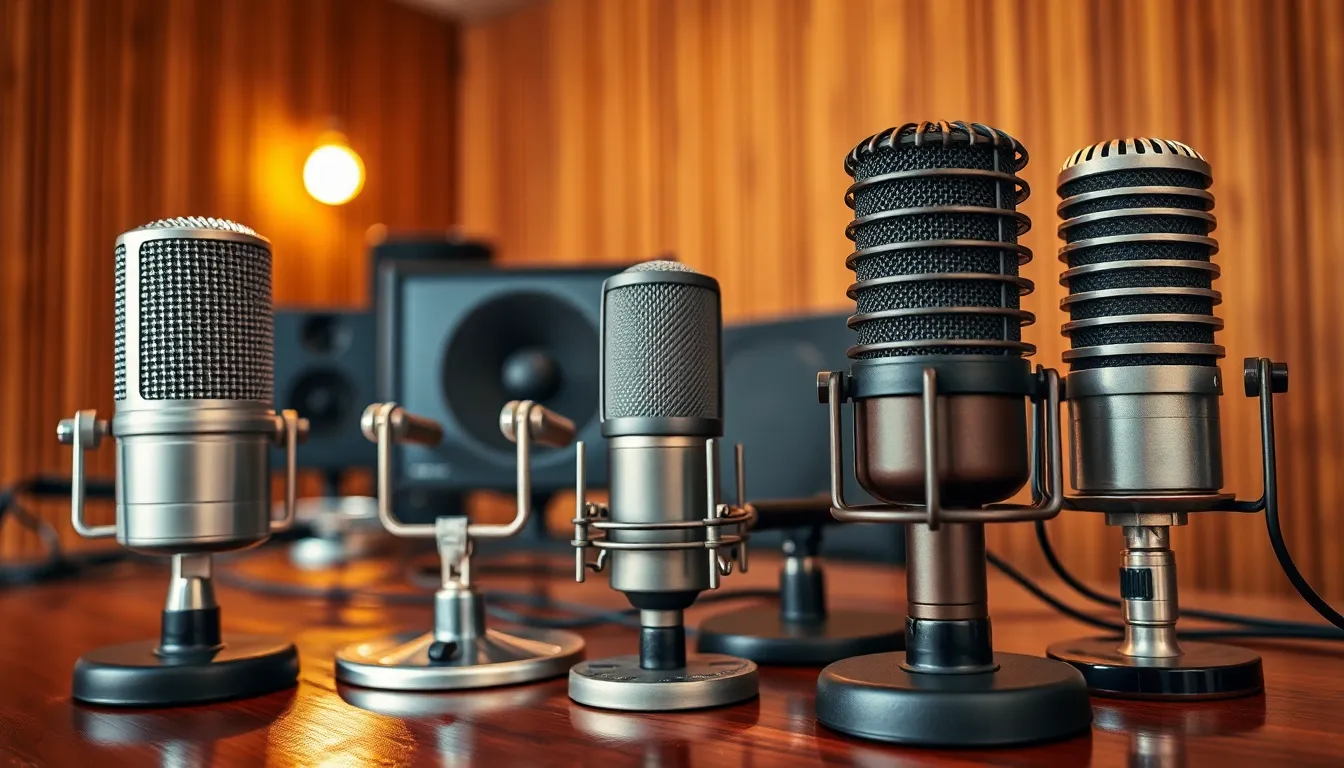In the world of audio recording, studio microphones are the unsung heroes, quietly transforming raw sound into musical magic. Whether it’s capturing the perfect vocal take or giving instruments their moment in the spotlight, these little gadgets pack a punch. But let’s face it, not all microphones are created equal. Some might make you sound like a rockstar, while others might leave you sounding like a cat caught in a blender.
Table of Contents
ToggleOverview Of Studio Microphones
Studio microphones play a crucial role in audio recording. They capture sound with clarity, significantly affecting the quality of recorded audio. Various types of studio microphones exist, each designed for specific recording scenarios. Condenser microphones excel in capturing high-frequency sounds, making them popular for vocals and acoustic instruments. Dynamic microphones resist distortion, which benefits loud sound sources, such as guitar amplifiers and drums.
Another type, ribbon microphones, provides a warm sound, often preferred for vocals and strings. Each microphone’s design, including its polar pattern, impacts how sound is captured. Cardioid patterns focus on sound from the front, minimizing background noise. Omnidirectional patterns capture sound from all directions, useful for certain recording environments.
Understanding microphone specifications aids in choosing the right equipment. Sensitivity ratings indicate how well a microphone captures quieter sounds. Frequency response shows the range of sounds a microphone can capture effectively. Microphone placement also plays an important role; positioning can enhance a sound’s character.
Professional studios often contain a combination of microphone types to meet diverse recording needs. Selecting the right microphone can transform an ordinary recording into a polished masterpiece. Matching the microphone to the instrument or voice helps achieve the desired sound quality. Investing in quality studio microphones elevates overall production value, allowing artists to present their best work.
Types Of Studio Microphones

Studio microphones come in various types, each catering to specific recording needs. Understanding these types helps in selecting the right microphone for any project.
Dynamic Microphones
Dynamic microphones excel in handling high sound pressure levels, making them suitable for loud instruments like drums and guitar amplifiers. They feature a robust design that withstands wear and tear in live performances. These microphones capture sound using a diaphragm attached to a coil that moves within a magnetic field. The result is a clear sound reproduction, especially for aggressive sources. Additionally, dynamic microphones typically have a cardioid polar pattern, which reduces background noise and focuses on the sound source. Their reliability and durability often make them a staple in both studios and live settings.
Condenser Microphones
Condenser microphones are known for their sensitivity and ability to capture nuanced sound details. They utilize a diaphragm that vibrates in response to sound waves, translating them into electrical signals. This design allows for a broader frequency response, making them ideal for vocals and acoustic instruments. Often paired with phantom power, condenser microphones capture high-frequency information exceptionally well, resulting in clear and vibrant recordings. Many professionals gravitate towards these microphones for studio work because of their ability to reproduce subtle nuances in performances, enhancing overall audio quality.
Ribbon Microphones
Ribbon microphones deliver a warm and natural sound quality, often preferred for vocal and string recordings. They contain a thin metal ribbon suspended in a magnetic field, which vibrates in response to sound waves, converting them into an electrical signal. This unique mechanism provides a smooth frequency response and excellent transient response, giving recordings a unique character. While more delicate than dynamic and condenser types, ribbon microphones offer rich timbres that can elevate recordings. Many engineers use them in combination with other microphones to create a well-rounded sonic palette, enriching the overall production quality.
Key Features To Consider
Understanding studio microphones involves examining essential features that influence sound quality. Frequency response, sensitivity, and directionality play major roles in microphone performance.
Frequency Response
Frequency response defines a microphone’s ability to capture various sound frequencies. A wider frequency response range ensures accurate production of vocals and instruments. Most condenser microphones operate best between 20 Hz and 20 kHz, capturing both low and high sound characteristics. Dynamic microphones typically exhibit a narrower response, focusing on mid-range frequencies ideal for live performances. Selecting a microphone with a suitable frequency response helps achieve desired sound tones, making it critical for professional recordings.
Sensitivity
Sensitivity indicates how effectively a microphone converts sound pressure into an electrical signal. Higher sensitivity ratings result in better performance at lower sound levels. Condenser microphones usually offer greater sensitivity, making them excellent for capturing nuanced sounds, such as soft vocals or delicate instrumental notes. Dynamic microphones tend to have lower sensitivity, suitable for high sound pressure environments like loud amplifiers. Evaluating sensitivity ensures that recordings maintain clarity and detail, which directly impacts audio quality.
Directionality
Directionality refers to a microphone’s ability to capture sound from specific angles. Cardioid microphones primarily pick up sound from the front while reducing background noise from the sides and rear. This makes them ideal for vocal performances in controlled environments. Omnidirectional microphones, on the other hand, capture sound equally from all directions, providing a more ambient audio experience. Knowing the directionality of a microphone assists in effectively managing recording setups and environments, allowing for improved sound isolation or natural room acoustics.
Popular Brands And Models
Numerous brands specialize in studio microphones, each offering unique features and designs suited to different recording needs. Two of the most recommended brands include Brand A and Brand B, which consistently receive positive feedback from audio professionals.
Brand A
Brand A is renowned for its high-quality condenser microphones. The model, A-1, captures sound with exceptional clarity and a wide frequency response of 20 Hz to 20 kHz. Users appreciate its ability to handle delicate vocal nuances. Built with a robust design, it also withstands the rigors of regular studio use. Fine-tuning is easier with its adjustable sensitivity settings, making it versatile for different recording environments. Audio engineers often favor this brand for its reliability and performance, ensuring optimal sound capture for various applications.
Brand B
Brand B shines in the dynamic microphone category, with its popular model B-2. This microphone excels in noisy environments and handles high sound pressure levels effectively. A cardioid polar pattern allows it to target sound sources while minimizing background noise. Robust construction ensures longevity, appealing to musicians and performers alike. The frequency response primarily focuses on mid-range sounds, perfect for vocals and instruments. Feedback from users emphasizes its affordability, making it a go-to choice for beginners and professionals in need of dependable, quality equipment.
Choosing the right studio microphone can significantly impact the quality of audio recordings. With various types available each tailored for specific applications understanding their features is essential for achieving the best results. Whether it’s the clarity of a condenser microphone the durability of a dynamic model or the warmth of a ribbon microphone the right choice elevates any recording project.
Investing in quality microphones from reputable brands ensures reliability and performance. By considering factors like frequency response sensitivity and directionality artists and producers can make informed decisions that lead to polished and professional-sounding tracks. Ultimately the right microphone not only captures sound but also enhances the creative vision behind every recording.







